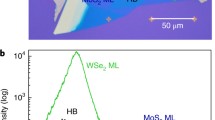Abstract
A dimensionally confined dielectric constant and reduced dielectric screening lead to two-dimensional transition-metal dichalcogenides (TMDs). The confined dielectric constant triggers a strong Coulomb interaction and high exciton binding energies between TMD heterostructures. Here we show a highly efficient interlayer charged exciton or trion formation and its generation sites are present in materials at room temperature. Two different transition metals (Mo, W) and chalcogenide (S, Se) elements were investigated in two different heterostructure combinations (MoS2—WS2 and MoSe2—WS2). Room temperature photoluminescence measurements demonstrate a highly efficient trion formation between and close to the heterostructure interfaces. This study highlights an effective band alignment, strong photoexciting Coulomb interaction, and formation of interlayer trions with different recombination energies. This investigation suggests the possibility of utilizing interlayer trions in promising optoelectronic devices in the future.
Similar content being viewed by others
References
F. A. Rasmussen and K. S. Thygesen, J. Phys. Chem. C 119, 13169 (2015).
R. Roldán et al., Ann. Phys. 526, 347 (2014).
J. Gusakova et al., Phys. Status Solidi A 214, 1700218 (2017).
K. Matsuda, J. Phys. Soc. Jpn. 84, 121009 (2015).
M. Bernardi, C. Ataca, M. Palummo and J. C. Grossman, Nanophotonics 6, 479 (2016).
K. F. Mak and J. Shan, Nat. Photonics 10, 216 (2016).
H-P. Komsa and A. V. Krasheninnikov, Phys. Rev. B 88, 085318 (2013).
B. Amin, N. Singh and U. Schwingenschlögl, Phys. Rev. B 92, 075439 (2015).
M. Z. Bellus, F. Ceballos, H-Y. Chiu and H. Zhao, ACS Nano 9, 6459 (2015).
C. Choi et al., NPJ 2D Mater. Appl. 2, 1 (2018).
S. Kallatt, S. Das, S. Chatterjee and K. Majumdar, NPJ 2D Mater. Appl. 3, 1 (2019).
Y. Huang et al., ACS Nano 9, 10612 (2015).
R. Frisenda et al., Chem. Soc. Rev. 47, 53 (2018).
Acknowledgments
This work was supported by the Institute for Basic Science of Korea (IBS-R011-D1) and the Basic Science Research Program through the National Research Foundation of Korea (NRF) funded by the Ministry of Education (2018R1D1A1A02046206). The authors acknowledge Prof. Young Hee Lee for his support for the successful completion of this work.
Author information
Authors and Affiliations
Corresponding author
Rights and permissions
About this article
Cite this article
Biswas, C., Sebait, R. Interlayer Trions in 2D Transition-Metal Dichalcogenide Heterostructures. J. Korean Phys. Soc. 77, 850–852 (2020). https://doi.org/10.3938/jkps.77.850
Received:
Accepted:
Published:
Issue Date:
DOI: https://doi.org/10.3938/jkps.77.850




